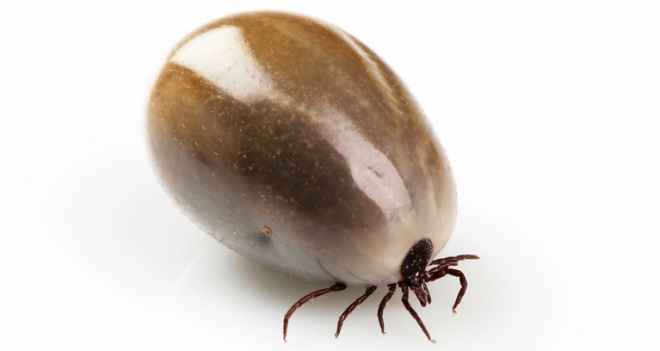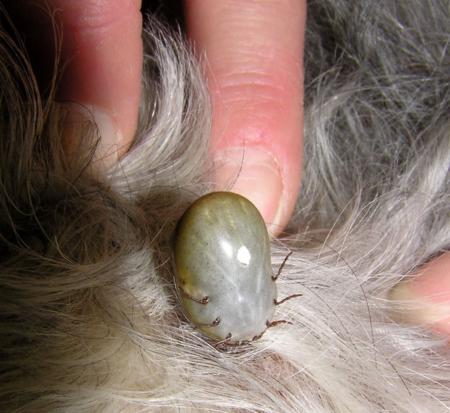
Ticks seem to be a sexy topic these days. My in-depth online analysis (5 minutes of fiddling on Google) revealed that Canadians search for the word “tick” 3,600 times every month. “Flea” searches were a fair bit behind, at 2,900. Poor little “heartworm” ranked a distant third at 590 measly queries per month.
Every spring, we do our best to educate our clients on the dangers of heartworm infection and the grossness of flea infestations. The lowly tick is almost always an afterthought.
Well, not today. Today, it’s ticks, ticks and more ticks. ‘Cause that’s what the people want. Apparently.
Ticks are arachnids, like their cousins the spiders, scorpions and mites, and have eight legs as an adult. Aside from being absolutely disgusting, ticks are also extremely efficient carriers of disease. After attaching firmly to their host, they slowly suck blood to feed and can often go for days unnoticed. Once fully fed and engorged, a female tick will mate, fall to the ground, and lay 3,000 to 6,000 eggs. That’s a lot of eggs.
These eggs hatch into tiny larvae, which feed on small rodents and mammals. Larvae molt and turn into larger nymphs, which feed off a new host, and molt into larger adult ticks. These adults climb up on the tips of grasses and shrubs, waiting for some poor bugger (canine or human) to come wandering by. The tick lets go of its perch and crawls onto the new host, where the whole circle of life starts all over again. The entire process can take anywhere from two months to more than two years, depending on the species of tick.
Ticks are probably most famous for being the carriers of Borrelia burgdorferi, the bacteria that causes Lyme disease. Lyme disease can infect people as well as dogs, and can cause lameness, pain, fever and lethargy. Humans are actually much more susceptible than dogs are. In fact, only 5-10 % of infected dogs will ever show any clinical signs of lyme disease. Some veterinary clinics recommend yearly screening tests in all dogs to look for evidence of lyme disease (and other tick transmitted diseases). Currently, we do not. Here are the reasons why:
- Lyme disease, although it can occur in our patients, is not very common. This may change in the future, as ticks are spreading and becoming more of a problem everywhere. In endemic areas like southwestern Ontario, testing may be more useful. Click here if you’d like to see a map of the high risk areas in Canada. Click here if you’d like to see a video of a cat playing with a dolphin.
- Nobody knows what to do with a healthy dog that tests positive for lyme disease. Well, lots of people have opinions on what to do, but nobody really knows. We just don’t have enough studies or data to know whether or not it is useful to treat dogs that have no clinical signs of lyme disease, but test positive on a screening tests. Some vets do. Some vets don’t. What we do know, is that a large majority of infected dogs will never have any problems.
- Testing is far more useful on a dog that is showing signs of lyme disease. If I have a clinical suspicion that lyme disease could be causing a patient’s signs of fever, lethargy or lameness, than you can be darn sure that I will recommend testing for lyme disease. A positive result in a patient like this would be far more significant, and less likely to be a false negative result.
- Vets are kind and goodhearted people that don’t want you to spend your money unwisely. Spend it on things like regular wellness testing and annual checkups instead. These things make a big difference. Seriously.
Aside from lyme disease, there are a smattering of other infectious diseases that ticks can spread from dog to dog. The good news is that most of these diseases respond to treatment with certain types of antibiotics. Hopefully, it’ll never get to that point though… Our goal is to help prevent disease, and so the real question is “How do I prevent my dog from getting these diseases in the first place?” Well, I’m glad you asked.
How to prevent your dog from getting these diseases in the first place:
- Keep your dog out of tall grass and brush. Dogs need close contact with ticks in order to become infected, so avoiding areas where ticks like to hang out is the easiest way to keep your pet out of harm’s way.
- Use a quality tick preventive product for your dog. Several tick preventives are available that either kill ticks after they have attached, or repel them so they don’t attach in the first place. Topical monthly medications and collars should be used beginning the middle of May and extending into the fall. Talk to us about what product is right for your pet.
- Inspect your dog for ticks daily. It takes at least 48 hours for a tick to transmit the bacteria causing lyme disease after attaching to your pet. Daily examination for ticks is the best way to ensure that they never have a chance to cause harm. Which leads us to…
- Remove any ticks found on your pet immediately. Ticks can sometimes be hard to remove. They bury their little arachnid mouth-parts under the skin and won’t let go for anything. Ticks need to be grasped firmly just above where they attach, and gently pulled straight up and away from your dog’s skin. You can use tweezers, or your fingertips if you’re brave. Just make sure to guard yourself against the tick with a tissue or rubber gloves — remember that people can get lyme disease too, and the organism that causes it can enter your body through a cut or abrasion. If in doubt, bring your dog in to have us do it. We just love removing ticks.
So there you have it. Ticks. Nasty little creatures, but fascinating all the same. We hope we haven’t grossed you out too much…






Thanx for the info! Love your light sense of ha ha as well. Esp. “click here to see a cat playing with a dolphin”, so I did! And it was a pretty entertaining li’l clip.
Haha. Glad you enjoyed it Tracy 🙂